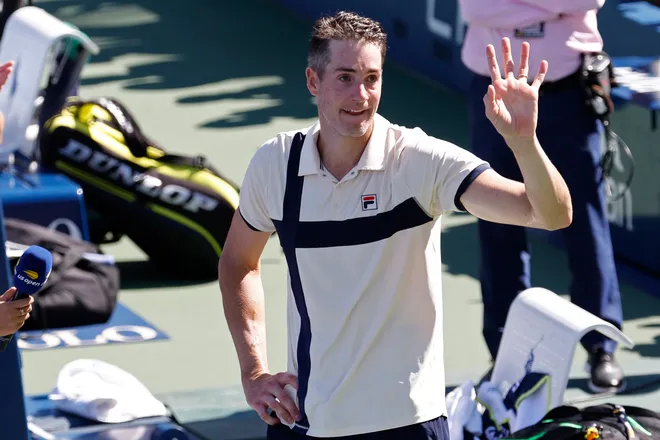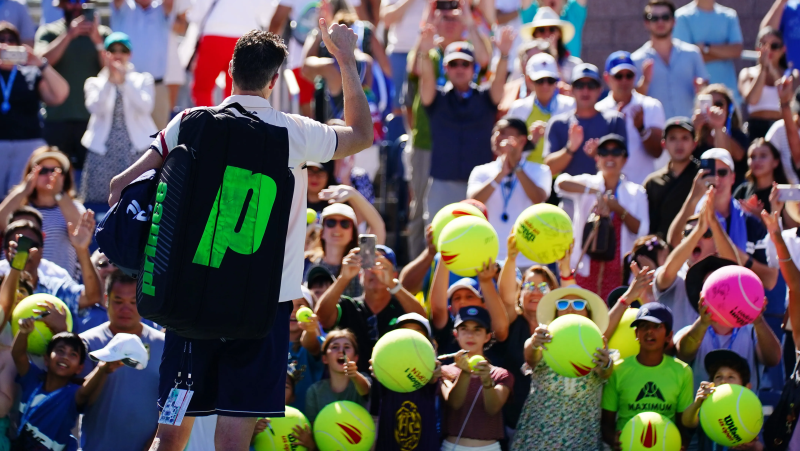Retiring John Isner helped change tennis, even if he never got the recognition he deserves
NEW YORK — When it was all over — not just the match but the remarkable career he wove together out of an extra tall body, a massive serve and a willingness to embrace what he was and wasn’t on a tennis court — John Isner put his face into a towel and sobbed, rubbing it up and down while his head shook.
Minutes earlier, Isner had earned a match point against Michael Mmoh and waved his arms to the crowd motioning for more noise. The fans who had packed the Grandstand court at Billie Jean King National Tennis Center had done everything in its power to carry Isner over the finish line for nearly four hours, trying to give the big man who represented the best of American tennis for a decade one more day at his final tournament before retirement. Isner had been up two sets to love and was so close to the third round and one last run, as close as a player can get without shaking hands as the winner.
But the US Open isn’t a fairy tale. It is an unforgiving event in a brutal sport, and the record-setting 829th tiebreaker of Isner’s career had left him struggling to put together whole sentences while his emotions spilled onto the concrete.
“It’s tough, you know,” Isner said, addressing the crowd that cheered like the match was still going on before his voice trailed off. “I like to think I work as hard as I can to…”
He never finished the thought. But regardless whether he won or lost Thursday, the chapter of tennis that Isner defined had already been written.
And it’s one deserving of more respect than it will likely get.
Even among American tennis fans, Isner’s career and impact on the sport will probably not resonate much beyond this event, which he announced last week would be his last.
The cold reality is that at age 38, Isner’s time as a relevant ATP Tour player had expired. He wasn’t winning many matches, his ranking had slipped outside the top-150 and the physical work it took just to get on the court was too difficult to endure.
“It's not easy to get a body like mine ready to play for 17 consecutive years,” Isner said earlier this week of the 6-foot-10 frame that made him unique but imperfect in a sport that requires so much endurance, agility, speed, strength and incredible skill. “It's not easy at all. That was the part I really enjoyed all throughout my career, but lately it's becoming tougher.
“It just wasn't much fun. It just became very laborious for me just trying to get myself healthy and not really being able to do it.”

The unvarnished truth is that many fans will say good riddance, as Isner represents a brand of tennis that can be difficult to appreciate and seems less relevant in a day and age where players really can’t have any weaknesses if they want to rise to the top of the sport.
Isner represented something different. He showed what it would look like for a player to come on tour and win lots and lots of matches with one huge weapon: A serve that produced an all-time record 14,470 aces, kept him hanging around the top-20 for a decade and earned 16 ATP Tour titles along with more than $22 million in prize money.
“I believe he has the best serve in the history of the game,” said three-time Grand Slam champion Andy Murray, who faced Isner nine times during their careers. “He was always a disaster to play against or see in your draw.”
But that gift, which made his peers both respect and fear him, did not translate to incredible popularity. For some reason, a player with a great forehand or backhand is mesmerizing. A player with a great serve gets tagged as a “servebot,” which is code for boring to watch.
Isner and some of the other servebots on tour like Reilly Opelka have played along and embraced the moniker, but it is one of the strange things about this sport that being so good at arguably the most important shot is seen as some type of negative.
In a sense, Isner hacked the sport because so many of his matches followed a similar pattern: Dominate on serve, often fail to break, then win tiebreakers where big servers have an advantage because there’s such a premium on the so-called “free points” that are won with aces or unreturned serves.
Isner did that extremely well for many, many years. But whereas some players and fans see tennis as an artistic expression, Isner made it clinical and repetitive and didn’t always get much appreciation for just how hard it was to pull off.
“I think he's the best server of all time,” said Mmoh, who only broke Isner once in five sets but found just enough returns to squeeze out a 3-6, 4-6, 7-6, 6-4, 7-6 victory. “So with that, you know, it's a huge challenge, even on your serve just because you know if you go down a break, that could be the set right there. I felt that pressure. I felt that dynamic of, you know, him maybe kind of not really giving me a rhythm, and then all of a sudden it’s 3-4 in the first set and he’s making six returns in a row and it's kind of surprising you, and then you feel that pressure because you know if you go down a break, it's basically set over.”
Unlike many players in his category who had good results for a long time but never reached a Grand Slam final, Isner leaves a two-pronged legacy on tennis beyond the serving records.
The first is that he filled a tremendous void at a dire time for U.S. tennis after guys like Andy Roddick and Mardy Fish exited the sport, carrying the banner for several years when there simply weren’t many American men playing on the biggest stages.
The second is his role in two of the defining Wimbledon matches of the era: The 70-68 fifth set that he won over Nicolas Mahut in 2010 and the 26-24 fifth set he lost in 2018 to Kevin Anderson in his only major semifinal appearance.
Now, all four Grand Slams have a standard super-tiebreaker (first to 10, win by two) played at 6-6 in the final set, largely because those marathon matches Isner played showed the downside of not having a way to finish matches if players kept holding serve.
It’s fitting, in a sense, that Isner’s career ended with the very thing that was invented to ensure 70-68 never happens again.
“I did take pride in being the top-ranked American for as many years as I was,” Isner said. “At the same time I also realized it wasn't the 1990s where America had five guys in the top 10. There were certainly times when I was the only person playing Madrid and Rome, the only American there, for a couple years. That was sort of weird for me. But, yeah, what my legacy is, I'm not sure.”
When he left the University of Georgia in 2007, Isner couldn't have expected any of this. It wasn't even clear he was going to become a successful pro until he went out on tour and his brand of tennis started working against some of the best players in the world.
By this year, all the miles had taken their toll. The US Open was a logical end, and those who never enjoyed watching Isner apply his craft probably won't think about him much anymore. But tennis always evolves, generation after generation pushing boundaries and changing the game. Despite his limits as a player, Isner undeniably had a role in that. And it’s one that should be remembered long after Thursday’s goodbye.

Disclaimer: The copyright of this article belongs to the original author. Reposting this article is solely for the purpose of information dissemination and does not constitute any investment advice. If there is any infringement, please contact us immediately. We will make corrections or deletions as necessary. Thank you.







